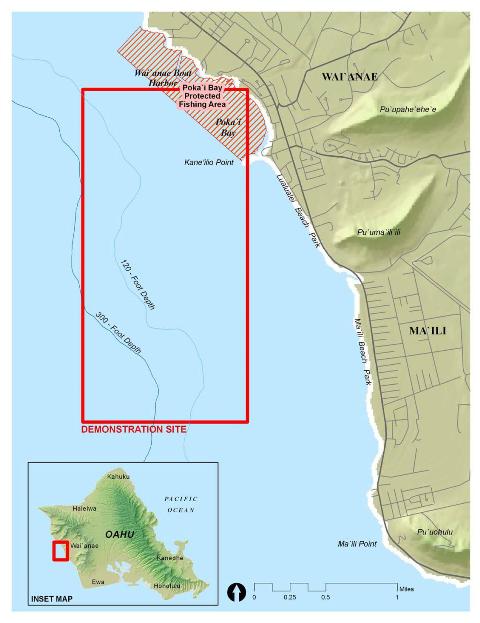
|
|
Ordnance Reef (Site HI-06) History
During a benthic survey of the Wai'anae WWTP sewage outfall in 1992, the City and
DEMONSTRATION SITE [Ordnance Reef (HI-06)] In 2002, the DoD tasked the US Army Corps of Engineers (USACE) to conduct a study of Ordnance Reef (HI-06) to determine its eligibility for the Defense Environmental Restoration Program - Formerly Used Defense Site (DERP-FUDS). At the USACE's request, the US Navy's Explosive Ordnance Disposal Detachment (EODD) provided diving and underwater survey support to the USACE's Ordnance Reef Wai'anae Sewage Outfall project, which was conducted under the DERP-FUDS program. The Navy's EODD surveyed Ordnance Reef (HI-06) and identified roughly 2,000 UWMM, which it categorized as most likely discarded military munitions (DMM). However, Ordnance Reef (HI-06) was determined not to be eligible for a response under the DERP-FUDS program because DoD never owned, leased, otherwise possessed the site, nor did it ever exercise control over it, except to use Ordnance Reef (HI-06) for the disposal of military munitions (ARA, 2010a). In May 2006, the Army and Navy subsequently funded NOAA to conduct a screening level survey of the Ordnance Reef (HI-06). The NOAA survey, which was limited to depths of 24 to approximately 300 feet, determined both the boundaries of Ordnance Reef (HI-06) and the locations of UWMM present, provided information for use in identifying the types and approximate quantities of UWMM detected, and analyzed sediment and fish tissue samples for MC (i.e., metals and explosives) (ARA, 2010a; NOAA, 2007). NOAA released its independent report in March 2007. The UWMM present extend from depths of approximately 30 feet to over 300 feet, the maximum depth of the study. Many of the UWMM observed were heavily fouled with algae and benthic organisms. In some cases, munitions were observed with substantial coral growth. The report, which provided the DoD with screening-level data, also provided the basis for assessing the potential explosives safety and human health or environmental risks associated with the UWMM present and for making a determination of whether a response was required. The Army's and Navy's explosives safety centers concluded that the UWMM present did not pose an immediate explosives safety risk to the public, and only deliberate activities (e.g., divers disturbing UWMM) posed a threat to those who use Ordnance Reef (HI-06) for recreational-related and other activities. The DoD Explosives Safety Board endorsed this conclusion. The Army, as part of its 3Rs (Recognize, Retreat, Report) Explosives Safety Education Program (Recognize–when you have encountered a munition and that munitions are dangerous, Retreat–do not touch, move or disturb it, Report–call 911) implemented a comprehensive public education effort that focused on, but was not limited to, the communities near Ordnance Reef (HI-06) (i.e., Wai'anae and Nānākuli). Army's Center for Health Promotion and Preventive Medicine (USACHPPM), now the Army's Pubic Health Command, and the Navy's Environmental Health Center, the agencies responsible for health and environmental risk assessments, concluded that (a) the contaminant levels from any MC detected were all well below risk-based levels; and (b) the only metalsdetected in fish tissue did not appear to be MC associated with the UWMM present at Ordnance Reef (HI-06). Based on available data, these assessors concluded that it was unlikely that the UWMM posed a health risk to humans. The ecological evaluation found no overt signs of stress or ecological impact. However, both agencies concluded that there were data gaps that needed to be addressed to answer the community's questions regarding possible risk to human health and/or the potential contamination of ocean food resources. The US Department of Health and Human Services' (DHHS), Center for Disease Control, Agency for Toxic Substances and Disease Registry (ATSDR) performed a health consultation for Ordnance Reef (HI-06) based on the NOAA's report. ATSDR, which considers ingestion of biota as the most significant way people could contact chemicals, concluded contact with chemicals (i.e., MC) in sediments would not be of sufficient frequency to present a hazard by ingestion or dermal contact. ATSDR indicated that explosive MC were not detected in fish tissue, and the inorganic chemicals detected in fish tissue are not a public health hazard (ATSDR, 2007). After review of NOAA's report, DoD (Army) determined that data gaps existed that would
need to be addressed to make a definitive determination as to whether the UWMM at Ordnance
Reef (HI-06) posed a risk to human health. In December 2007, the Army tasked USACE's
Pacific Ocean Division to: (a) work with state agencies and potentially affected communities
using its technical project planning process to identify study questions that a follow-on
investigation should answer; and (b) determine the steps and information required to close the
data gaps and reach a valid answer to those questions. In January 2008, USACE held an initial
meeting with the Ordnance Reef Coordinating Council (ORCC) that the Army established, on The Army subsequently obtained assistance from the University of Hawai'i (UH) to
|
| Copyright © 2011 Ordnance Reef Hawaii | |
